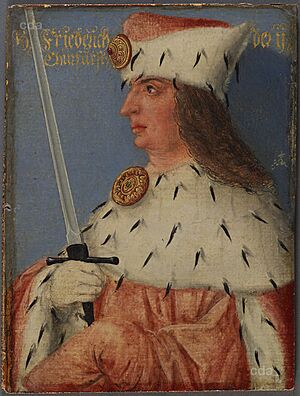Frederick II, Elector of Saxony facts for kids
Quick facts for kids Frederick II |
|
|---|---|

Portrait by Lucas Cranach the Younger
|
|
| Elector of Saxony | |
| Reign | 4 January 1428 – 7 September 1464 |
| Predecessor | Frederick I |
| Successor | Ernest |
| Landgrave of Thuringia | |
| Reign | 7 May 1440 - 1445 |
| Predecessor | Frederick IV |
| Successor | William II |
| Margrave of Meissen and Duke of Saxony | |
| Reign | 4 January 1428 – 7 September 1464 |
| Predecessor | Frederick IV/I |
| Successor | Albert IV/III |
| Born | 22 August 1412 Leipzig, Electorate of Saxony, Holy Roman Empire |
| Died | 7 September 1464 (aged 52) Leipzig, Electorate of Saxony, Holy Roman Empire |
| Burial | Meissen Cathedral |
| Spouse |
Margaret of Austria
(m. 1431) |
| Issue among others... |
Amalia, Duchess of Bavaria Anna, Electress of Brandenburg Ernest, Elector of Saxony Albert, Duke of Saxony Hedwig, Abbess of Quedlinburg |
| House | House of Wettin |
| Father | Frederick I, Elector of Saxony |
| Mother | Catherine of Brunswick and Lunenburg |
Frederick II, also known as Frederick the Gentle (born August 22, 1412 – died September 7, 1464), was an important ruler in a part of Germany called Saxony. He was the Elector of Saxony from 1428 to 1464. He also held the title of Landgrave of Thuringia for a few years, from 1440 to 1445.
Contents
Frederick's Life and Rule
Frederick was born in Leipzig. He was the oldest of seven children. His parents were Frederick I, Elector of Saxony and Catherine of Brunswick and Lunenburg.
When his father died in 1428, Frederick began to rule. He shared power with his younger brothers, William III, Henry, and Sigismund.
Peace and Parliament
In 1433, Frederick and his family, the Wettins, finally made peace with the Hussites. The Hussites were a religious group that had been fighting wars.
In 1438, Frederick led his Saxon army to victory in the Battle of Sellnitz. This was an important win for his region.
That same year, something very important happened in Saxony. The first "federal state parliament" was formed. This parliament was a group of people who represented different parts of Saxony. They gained the right to meet and discuss money matters, even without the ruler calling them together. This was a big step towards shared government.
Also in 1438, it was decided that Frederick had the right to vote for the German king. This was a very powerful position. He helped Albert II become king. Two years later, he did the same for his brother-in-law, Frederick.
Dividing the Land
After his brother Henry died in 1435, and Sigismund became a bishop in 1440, Frederick and William decided to divide their lands. In 1445, they made a deal called the Division of Altenburg.
William III received the areas of Thuringia and Franconia. Frederick received the eastern part of their lands. However, the valuable mines in the region remained shared property.
The Saxon Brother War
Disagreements about how the lands were divided led to a conflict in 1446. This was known as the Saxon Brother War. The war finally ended on January 27, 1451, with the Peace of Naumburg.
In 1459, Frederick, Duke William III, and the King of Bohemia, George of Podebrady, signed the Treaty of Eger. This treaty officially set the borders between Bohemia and Saxony. These borders, along the Ore Mountains (Erzgebirge) and the middle of the Elbe River, are still in place today. This makes them some of the oldest existing borders in Europe!
After Frederick's Death
Frederick died in Leipzig in 1464. His two sons, Ernest and Albert, took over ruling together. Later, when Duke William III died in 1482, the region of Thuringia returned to Frederick's family line.
Frederick's Family
Frederick married Margaret of Austria on June 3, 1431, in Leipzig. Margaret was the daughter of Ernest of Austria. They had eight children:
- Amalia (born 1436 – died 1501). She married Louis IX, Duke of Bavaria.
- Anna (born 1437 – died 1512). She married Albert III Achilles, Elector of Brandenburg.
- Frederick (born 1439 – died 1451).
- Ernest, Elector of Saxony (born 1441 – died 1486).
- Albert, Duke of Saxony (born 1443 – died 1500).
- Margaret (born 1444 – died 1498). She became an Abbess, a leader in a religious community.
- Hedwig (born 1445 – died 1511). She also became an Abbess of Quedlinburg.
- Alexander (born 1447 – died 1447).
In July 1455, a knight named Kunz von Kaufungen tried to kidnap Frederick's sons, Ernest and Albert. This event is known as the Prinzenraub (which means "Prince Robbery"). Kunz was trying to take them to Bohemia, but his plan was discovered by accident, and the princes were safely returned.
Images for kids
|
Frederick II, Elector of Saxony
Born: 22 August 1412 Died: 7 September 1464 |
||
| Regnal titles | ||
|---|---|---|
| Preceded by Frederick I |
Elector of Saxony 1428–1464 |
Succeeded by Ernest |
| Duke of Saxony and Margrave of Meissen 1428–1464 |
Succeeded by Albert |
|
| Preceded by Frederick IV |
Landgrave of Thuringia 1440–1445 |
Succeeded by William II |
See also
 In Spanish: Federico II de Sajonia para niños
In Spanish: Federico II de Sajonia para niños



